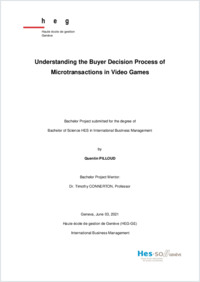Understanding the buyer decision process of microtransactions in video games
SONAR|HES-SO
- Pilloud, Quentin
- Connerton, Timothy (Degree supervisor)
- Genève : Haute école de gestion de Genève
124 p.
Bachelor of Science HES in International Business Management: Haute école de gestion de Genève, 2021
English
Selling virtual goods and services for real money has become an increasingly ordinary additional revenue model for video games; these are called microtransactions. This paper aims to understand the buyer decision process specific to microtransactions in video games. For that purpose, this paper has been evaluating the validity of the Kotler and Armstrong (2018) model on the buyer decision process in the modern context of microtransactions. That model is divided into five distinct steps that consumers go through for any purchase, namely Need recognition, Information search, Evaluation of alternatives, Purchase decision, and Postpurchase behavior. When acknowledging the monopolistic position of the game developers as the sole provider of microtransactions on its respective game, the predatory marketing methods used in the industry, the captive pricing or optional-product pricing strategies, and the unbalance of power between seller and buyers, it was possible to observe that the behavior of consumers would not fit the theoretical guidelines set by the model. An exhaustive review of the existing literature helped to draft a survey. The latter was distributed to gamers to assess their behavior and thought process while exposed to microtransactions. Both consumers and non-consumers have shared their behavior and feelings. It resulted in both qualitative and quantitative data. Additionally, online interviews have been conducted with a representative sample amongst the willing respondents based on their answers to further develop their point of view. The results of the primary research have been interpreted through the scope of the five steps of the model, assessing each step individually and the model as a whole. The average behavior of consumers fits most of the model, apart from the third step, Evaluation of alternatives, which is not taking place due to the lack of alternative brands in a monopolistic setting. Furthermore, the results show a clear dislike towards microtransaction, even for heavy consumers. The paradox seems to be resolved by the necessity to purchase to fully enjoy the game. Additionally, a notable share of consumers behaves in a way that does not fit the guidelines. The strong stimuli of the game developers, as well as other social and psychological factors, seem to influence and shorten the buyer decision process. Ultimately, the thesis highlights the need to further research the influencing factors that lead to such behavior. The thesis also calls attention to some possible ethical and legal problems that can arise from the monopolistic position of game developers and question the possibility of having a game that is neither open source nor monopolistic, by letting third parties enter the market and compete on selling microtransactions, reducing development costs, reducing prices, and increasing customization, which would potentially maximize total welfare of the stakeholders.
- Language
-
- English
- Classification
- Economics
- Notes
-
- Haute école de gestion Genève
- International Business Management
- hesso:hegge
- Persistent URL
- https://folia.unifr.ch/global/documents/319803
Statistics
Document views: 517
File downloads:
- PILLOUD_Quentin_Bachelor_Project_Final_IBM_2021.pdf: 894
